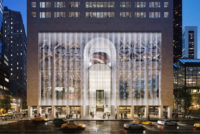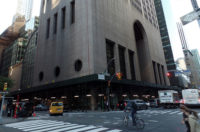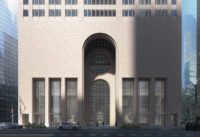Robert Stern Protests Snøhetta’s Proposal for Former AT&T Building by Philip Johnson

Robert A.M. Stern cradles a hastily-assembled model he used to recreate Philip Johnson’s 1979 TIME magazine cover photo outside the lobby of 550 Madison Avenue, the former AT&T Building, on Friday November 3, 2017.
Photo courtesy Robert A.M. Stern Architects (left), © Matthew G. Bisanz (right)

About 20 people gathered last Friday to protest Snøhetta’s design proposal, which would replace the lobby and atrium’s Stony Creek granite facade with a glass curtain wall.
Photo © Architectural Record

Journalist Nathan Eddy (holding the blue “HANDS OFF MY JOHNSON” sign) organized the protest; he is currently making a documentary about the life and works of Philip Johnson.
Photo © Architectural Record

Nathan Eddy and Hilary Lewis, chief curator and creative director at The Glass House, attended Friday’s protest.
Photo © Architectural Record




Last week, plans to transform Philip Johnson and John Burgee’s 1984 AT&T Building were released to the public and sparked outrage from around the profession—so much so that some, like architect Robert A.M. Stern, even took to the streets.
Snøhetta’s proposal would replace the lower level’s street-facing facade with a glass curtain wall, flooding the lobby and atrium spaces of 550 Madison Avenue, as the building is now known, with light. “The re-imagined 550 Madison reflects how we work and live in New York today,” according to a statement on the Norwegian firm’s website.
When Stern saw Snøhetta’s design, however, he was shocked.
“I think it’s an unforgiveable violation to a great work of architecture. One architect, in my view, should not do that to another architect’s building,” he told RECORD. So when Stern heard from there was a protest being organized in response to the design, he decided to “show the flag.”
Stern hastily assembled a model of the AT&T Building, posing with it for a photographer he invited (“Having some photo documentation might not be a bad idea,” he said) as he stood beneath the scaffolding at 550 Madison Avenue on last Friday’s unusually warm afternoon.

The resulting photos of Stern nod to a Time magazine cover from January 1979, which featured a severe Johnson holding a model of the tower. The issue’s cover lines boldly announced the shift toward Postmodernism occurring in American design studios: “U.S. Architects Doing Their Own Thing.”
“This building in particular is essentially the icon of Postmodernism,” said Hilary Lewis, the chief curator at Philip Johnson’s Glass House, who was among the 20-person protest last week. She remembered the excitement of seeing Johnson’s building constructed in the early ‘80s. “When a building is done with great integrity and expense as this building was, – you have to give a bit more careful consideration before you make massive changes,” she said.
With the gathering last Friday, Stern and his fellow protestors hope to catch the attention of the building’s current owner, Olayan America, and the Landmarks Preservation Commission, to change their minds about going forward with Snøhetta’s proposal.
“I truly believe this building can be repurposed without being ruined,” said Stern.







